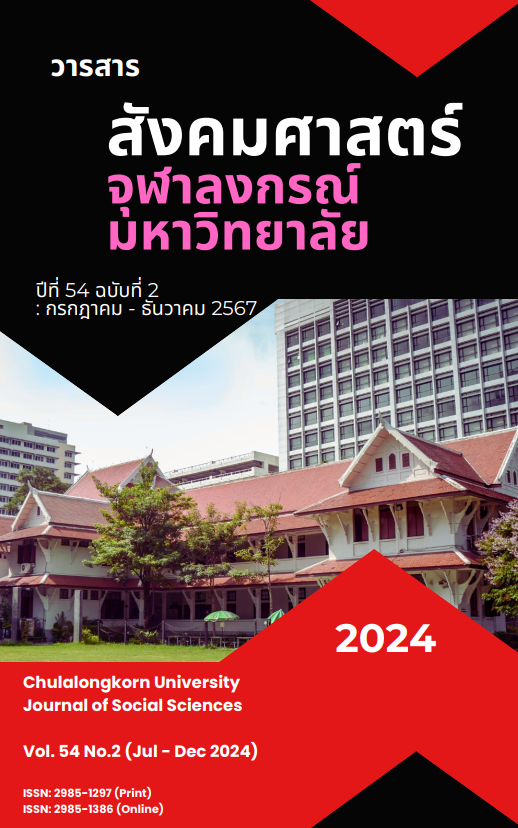การเรียนรู้ของผู้เข้าชมคนไทยในพิพิธภัณฑ์วิทยาศาสตร์
DOI:
https://doi.org/10.61462/cujss.v54i2.3335คำสำคัญ:
พิพิธภัณฑ์ศึกษา, การสื่อสารทางวิทยาศาสตร์, การพัฒนาทรัพยากรมนุษย์, การเรียนรู้ตลอดชีวิต, การเรียนรู้จากการชมพิพิธภัณฑ์บทคัดย่อ
พิพิธภัณฑ์วิทยาศาสตร์เป็นแหล่งเรียนรู้ที่มีศักยภาพในการเป็นสถานที่บ่มเพาะความรู้และแรงบันดาลใจทางวิทยาศาสตร์ เทคโนโลยีและนวัตกรรมที่สนับสนุนยุทธศาสตร์การขับเคลื่อนเศรษฐกิจของประเทศด้วยนวัตกรรมที่ช่วยเพิ่มมูลค่าสินค้า การดำเนินการภายใต้ยุทธศาสตร์นี้จำเป็นจะต้องให้ความสำคัญกับการพัฒนาแหล่งเรียนรู้ตลอดชีวิตทางวิทยาศาสตร์ให้มีลักษณะ รูปแบบและเนื้อหาของนิทรรศการให้สนองต่อการเรียนรู้และความต้องการของประชาชนผู้เข้าชม งานวิจัยนี้มีจุดประสงค์ในการศึกษาระดับการมีปฏิสัมพันธ์กับนิทรรศการวิทยาศาสตร์ของผู้เข้าชมชาวไทย พร้อมทั้งปัจจัยบริบทที่มีผลต่อการมีปฏิสัมพันธ์กับสื่อการเรียนรู้ในนิทรรศการวิทยาศาสตร์ จากผู้เข้าชมกลุ่มครอบครัวจำนวน 25 คู่ (50 คน) ภายใต้บริบทของพิพิธภัณฑ์วิทยาศาสตร์แห่งชาติ ทั้งนี้เพื่อกำหนดขอบเขตความรู้ความเข้าใจในปัจจุบันเกี่ยวกับพฤติกรรมการเข้าชมที่บ่งชี้ระดับความลึกของการเรียนรู้ในเรื่องที่เกี่ยวกับนิทรรศการ ตลอดจนปัจจัยที่ผู้เข้าชมระบุว่าส่งผลต่อการมีปฏิสัมพันธ์กับนิทรรศการ ผลการวิจัยพบว่าผู้เข้าชมกลุ่มผู้ปกครองและกลุ่มบุตรหลานร้อยละ 80 ขึ้นไปมีระดับการปฏิสัมพันธ์ต่อนิทรรศการอยู่ที่ระดับเปลี่ยนผ่านไปสู่ปฏิสัมพันธ์ที่ลึกขึ้น (Transitioning behavior) ถึงระดับปฏิสัมพันธ์ขั้นลึก (Breakthrough behavior) นอกจากนี้ผลการศึกษาปัจจัยที่มีผลต่อการมีปฏิสัมพันธ์กับนิทรรศการชี้ให้เห็นว่านิทรรศการวิทยาศาสตร์ในปัจจุบันต้องเพิ่มเติมเรื่องสื่อสารวิทยาศาสตร์ให้ผู้เข้าชมเข้าใจการประยุกต์ใช้วิทยาศาสตร์และความเกี่ยวข้องของวิทยาศาสตร์กับชีวิตประจำวันของตน รวมไปถึงการรักษาสมดุลการมอบความรู้และความบันเทิงในการออกแบบนิทรรศการ
Downloads
เอกสารอ้างอิง
Andre, Lucija, Tracy Durksen, and Monique Volman. 2017. “Museums as Avenues of Learning for Children: A Decade of Research.” Learning Environments Research 20: 47–76. https://doi.org/10.1007/s10984-016-9222-9.
American Association for the Advancement of Science. 2013. Communicating Science to Policy Makers. Accessed August 10, 2024. http://www.aaas.org/pes/communicating-science-policy-makers.
Archer, Louise, Emily Dawson, Amy Seakins, และ Billy Wong. 2016. “Disorientating, Fun or Meaningful? Disadvantaged Families’ Experiences of a Science Museum Visit”. Cultural Studies of Science Education 11 (4): 917–39. https://doi.org/10.1007/s11422-015-9667-7.
Aurentz, David J., Stefanie L. Kerns, และ Lisa R. Shibley. 2011. “Improving Student Perceptions of Science through the Use of State-of-the-Art Instrumentation in General Chemistry Laboratory”. Journal of College Science Teaching 40 (6): 12–17. https://doi.org/10.2505/3/jcst11_040_06.
Barriault, Chantal, and David Pearson. 2010. “Assessing Exhibits for Learning in Science Centers: A Practical Tool.” Visitor Studies 13 (1): 90–106. https://doi.org/10.1080/10645571003618824.
Besley, John C., and Andrea H. Tanner. 2011. “What Science Communication Scholars Think About Training Scientists to Communicate.” Science Communication 33 (2): 239–63. https://doi.org/10.1177/1075547010386972.
Bitgood, Stephen. 2013. Attention and Value: Keys to Understanding Museum Visitors. Walnut Creek, CA: Left Coast Press. https://doi.org/10.4324/9781315433455.
Bitgood, Stephen. 2014. “Exhibition Design That Provides High Value and Engages Visitor Attention.” Exhibitionist, no. spring’14, 6–11.
Braun, Virginia, and Victoria Clarke. 2006. “Using Thematic Analysis in Psychology.” Qualitative Research in Psychology 3 (2): 77–101. https://doi.org/10.1191/1478088706qp063oa.
Bruyas, Anne-Marie, and Michaela Riccio, eds. 2013. Science Centres and Science Events: A Science Communication Handbook. Milano: Springer Milan. https://doi.org/10.1007/978-88-470-2556-1.
DiClemente, Carlo C., and James O. Prochaska. 1982. “Self-Change and Therapy Change of Smoking Behavior: A Comparison of Processes of Change in Cessation and Maintenance.” Addictive Behaviors 7 (2): 133–42. https://doi.org/10.1016/0306-4603(82)90038-7.
Falk, John. 2016. “Museum Audiences: A Visitor-Centered Perspective.” Loisir et Société / Society and Leisure 39 (3): 357–70. https://doi.org/10.1080/07053436.2016.1243830.
Falk, John H., and Leslie M. Adelman. 2003. “Investigating the Impact of Prior Knowledge and Interest on Aquarium Visitor Learning.” Journal of Research in Science Teaching 40 (2): 163–76. https://doi.org/10.1002/tea.10070.
Falk, John H., and Lynn D. Dierking. 2000. Learning from Museums: Visitor Experiences and the Making of Meaning. California: AltaMira Press.
Falk, John H., Lynn D. Dierking, and Marianna Adams. 2006. “Living in a Learning Society.” In A Companion to Museum Studies, edited by Sharon Macdonald, 323–39. Malden, MA, USA: Blackwell Publishing Ltd. https://doi.org/10.1002/9780470996836.ch19.
Falk, John H., and Lynn D. Dierking. 2019. “Reimagining Public Science Education: The Role of Lifelong Free-Choice Learning.” Disciplinary and Interdisciplinary Science Education Research 1 (1): 10. https://doi.org/10.1186/s43031-019-0013-x.
Falk, John, and Martin Storksdieck. 2005. “Using the Contextual Model of Learning to Understand Visitor Learning from a Science Center Exhibition.” Science Education 89 (5): 744–78. https://doi.org/10.1002/sce.20078.
Hein, George. 1991. Constructivist Learning Theory. Institute for Inquiry. Accessed July 9, 2024. http://beta.edtechpolicy.org/AAASGW/Session2/const_inquiry_paper.pdf
Hein, George E. 1998. Learning in the Museum. London: Routledge. https://doi.org/10.4324/9780203028322.
Liebenberg, Linda, Aliya Jamal, and Janice Ikeda. 2020. “Extending Youth Voices in a Participatory Thematic Analysis Approach.” International Journal of Qualitative Methods 19 (January):1609406920934614. https://doi.org/10.1177/1609406920934614.
Jitsuchon, Somchai. 2012. “Thailand in a Middle-income Trap”. TDRI Quarterly Review 27 (2): 13–21. https://tdri.or.th/wp-content/uploads/2012/12/t5j2012-somchai.pdf
Jakobsson, Anders, and Eva Davidsson. 2012. “Using Sociocultural Frameworks to Understand the Significance of Interactions at Science and Technology Centers and Museums.” In Understanding Interactions at Science Centers and Museums: Approaching Sociocultural Perspectives, edited by Eva Davidsson and Anders Jakobsson, 3–21. Rotterdam: SensePublishers. https://doi.org/10.1007/978-94-6091-725-7_2.
National Strategy Secretariat Office. 2018. “Thailand National Strategy 2018-2037.” Accessed July 8, 2024. https://alro.go.th/uploads/org/admin_sys/download/article/article_20181029101644.pdf (in Thai)
Office of the National Economic and Social Development Council. 2017. "The Thirteenth National Economic and Social Development Plan (2023-2027)." Accessed July 5, 2024. https://www.nesdc.go.th/ewt_dl_link.php?nid=6422. (In Thai)
Office of the Education Council. 2017. “Thailand Education Scheme in Brief (2017-2036).” Accessed July 8, 2024. http://www.onec.go.th/index.php/book/BookView/1540. (In Thai)
Sjøberg, Svein. 2010. “Constructivism and Learning.” In International Encyclopedia of Education, 485–90. Elsevier. https://doi.org/10.1016/B978-0-08-044894-7.00467-X.
Sperling, Marko, Matthias Grünke, and Christin Coeppicus. 2019. “Graphic Organizer: An Efficient Tool for Learning-Disabled Students in a Museum.” The International Journal of the Inclusive Museum 12 (4): 57–66. https://doi.org/10.18848/1835-2014/CGP/v12i04/57-66.
Utz, Jenifer C., Candice M. Rausch, Laurie Fruth, Megan E. Thomas, and Frank van Breukelen. 2007. “Desert Survivors: The Design and Implementation of a Television Program to Enhance Local Scientific Literacy.” Advances in Physiology Education 31 (1): 1–4. https://doi.org/10.1152/advan.00030.2006.
Wertsch, James V. 1988. Vygotsky and the Social Formation of Mind. Cambridge, Mass: Harvard University Press.
ดาวน์โหลด
เผยแพร่แล้ว
รูปแบบการอ้างอิง
ฉบับ
ประเภทบทความ
สัญญาอนุญาต
ลิขสิทธิ์ (c) 2024 คณะรัฐศาสตร์ จุฬาลงกรณ์มหาวิทยาลัย

อนุญาตภายใต้เงื่อนไข Creative Commons Attribution-NonCommercial-NoDerivatives 4.0 International License.
เงื่อนไขการอนุญาตสาธารณะ
นโยบายลิขสิทธิ์และการอนุญาต
วารสารสังคมศาสตร์ จุฬาลงกรณ์มหาวิทยาลัย เผยแพร่เนื้อหาทั้งหมดภายใต้ สัญญาอนุญาตครีเอทีฟคอมมอนส์แบบแสดงที่มา-ไม่ใช้เพื่อการค้า-ไม่ดัดแปลง 4.0 นานาชาติ (CC BY-NC-ND 4.0)
ลิขสิทธิ์
บทความทั้งหมดที่ตีพิมพ์ในวารสารสังคมศาสตร์ จุฬาลงกรณ์มหาวิทยาลัย เป็นลิขสิทธิ์ของ คณะรัฐศาสตร์ จุฬาลงกรณ์มหาวิทยาลัย ผู้เขียนจะโอนสิทธิ์ทั้งหมดให้แก่วารสารเมื่อบทความได้รับการตอบรับให้ตีพิมพ์
สัญญาอนุญาต CC BY-NC-ND 4.0
ภายใต้สัญญาอนุญาตนี้:
-
แสดงที่มา (BY): ผู้ใช้ต้องแสดงที่มาโดยอ้างอิงถึงผู้เขียน คณะรัฐศาสตร์ จุฬาลงกรณ์มหาวิทยาลัย และวารสารสังคมศาสตร์ จุฬาลงกรณ์มหาวิทยาลัย พร้อมทั้งให้ลิงก์ไปยังสัญญาอนุญาต และระบุหากมีการเปลี่ยนแปลง ทั้งนี้สามารถทำได้ในลักษณะที่สมเหตุสมผล แต่ต้องไม่ทำในลักษณะที่แสดงว่าผู้อนุญาตให้การรับรองผู้ใช้หรือการใช้งานดังกล่าว
-
ไม่ใช้เพื่อการค้า (NC): ผู้ใช้ไม่สามารถใช้เนื้อหาเพื่อวัตถุประสงค์ทางการค้า การใช้งานเชิงพาณิชย์จะต้องได้รับอนุญาตเป็นลายลักษณ์อักษรล่วงหน้าจากผู้เขียนและคณะรัฐศาสตร์ จุฬาลงกรณ์มหาวิทยาลัย
-
ไม่ดัดแปลง (ND): หากผู้ใช้นำเนื้อหาไปรวม ดัดแปลง หรือต่อยอด ผู้ใช้ไม่สามารถเผยแพร่งานที่ดัดแปลงนั้นได้ การดัดแปลงผลงานจะต้องได้รับอนุญาตเป็นลายลักษณ์อักษรล่วงหน้าจากผู้เขียนและคณะรัฐศาสตร์ จุฬาลงกรณ์มหาวิทยาลัย
นโยบายการเข้าถึงแบบเปิด
วารสารสังคมศาสตร์ จุฬาลงกรณ์มหาวิทยาลัย ให้การเข้าถึงเนื้อหาแบบเปิดโดยทันทีตามหลักการที่ว่าการทำให้งานวิจัยสามารถเข้าถึงได้อย่างเสรีแก่สาธารณะจะสนับสนุนการแลกเปลี่ยนความรู้ในระดับโลก ผู้ใช้สามารถอ่าน ดาวน์โหลด คัดลอก เผยแพร่ พิมพ์ ค้นหา หรือเชื่อมโยงไปยังเนื้อหาฉบับเต็มของบทความได้โดยไม่ต้องขออนุญาตล่วงหน้าจากผู้จัดพิมพ์หรือผู้เขียน ทั้งนี้เป็นไปตามสัญญาอนุญาต CC BY-NC-ND 4.0
นโยบายการเก็บบันทึกด้วยตนเอง
ผู้เขียนสามารถเก็บบันทึกบทความฉบับตีพิมพ์สุดท้าย ต้นฉบับที่ส่ง (preprint) หรือฉบับที่ผ่านการประเมิน (postprint) ในคลังสถาบันหรือเว็บไซต์ส่วนตัวได้ โดยต้องมีการอ้างอิงการตีพิมพ์ครั้งแรกในวารสารสังคมศาสตร์ จุฬาลงกรณ์มหาวิทยาลัย พร้อมระบุแหล่งอ้างอิงที่สมบูรณ์และลิงก์ไปยังเว็บไซต์ของวารสาร
การขออนุญาต
สำหรับการใช้งานนอกเหนือจากที่ครอบคลุมโดยสัญญาอนุญาต CC BY-NC-ND 4.0 กรุณาติดต่อ:
กองบรรณาธิการ
วารสารสังคมศาสตร์ จุฬาลงกรณ์มหาวิทยาลัย
คณะรัฐศาสตร์ จุฬาลงกรณ์มหาวิทยาลัย
Email: cusocscij@gmail.com
สำหรับข้อมูลเพิ่มเติมเกี่ยวกับสัญญาอนุญาตครีเอทีฟคอมมอนส์แบบแสดงที่มา-ไม่ใช้เพื่อการค้า-ไม่ดัดแปลง 4.0 นานาชาติ กรุณาเยี่ยมชม: https://creativecommons.org/licenses/by-nc-nd/4.0/deed.th





